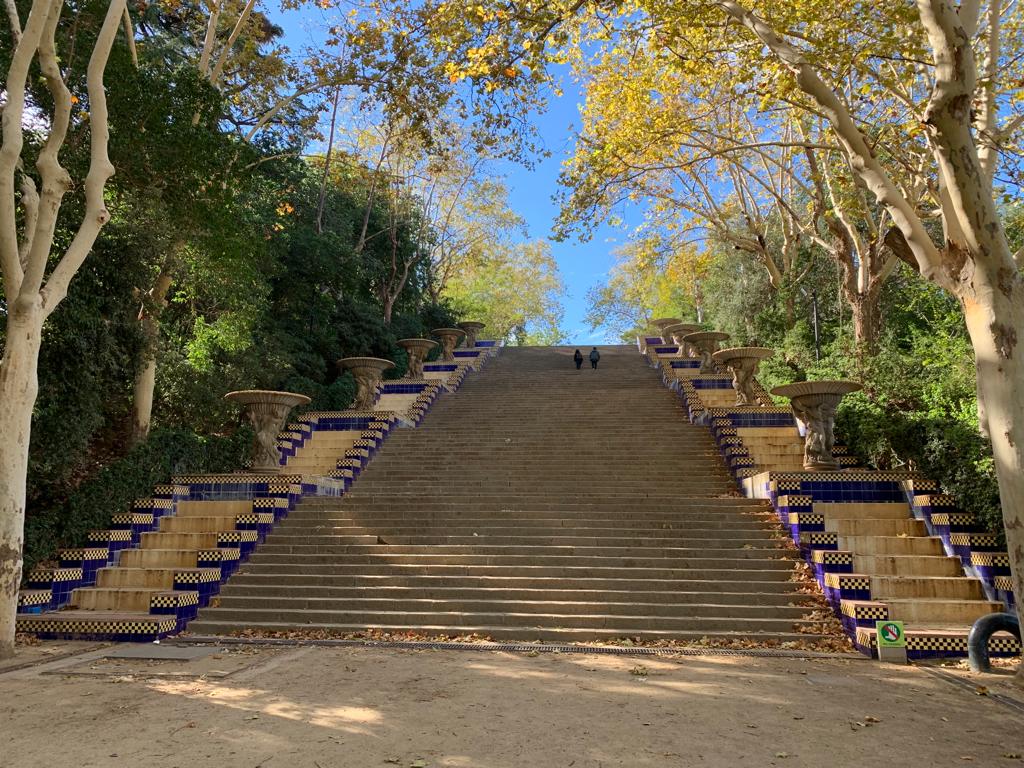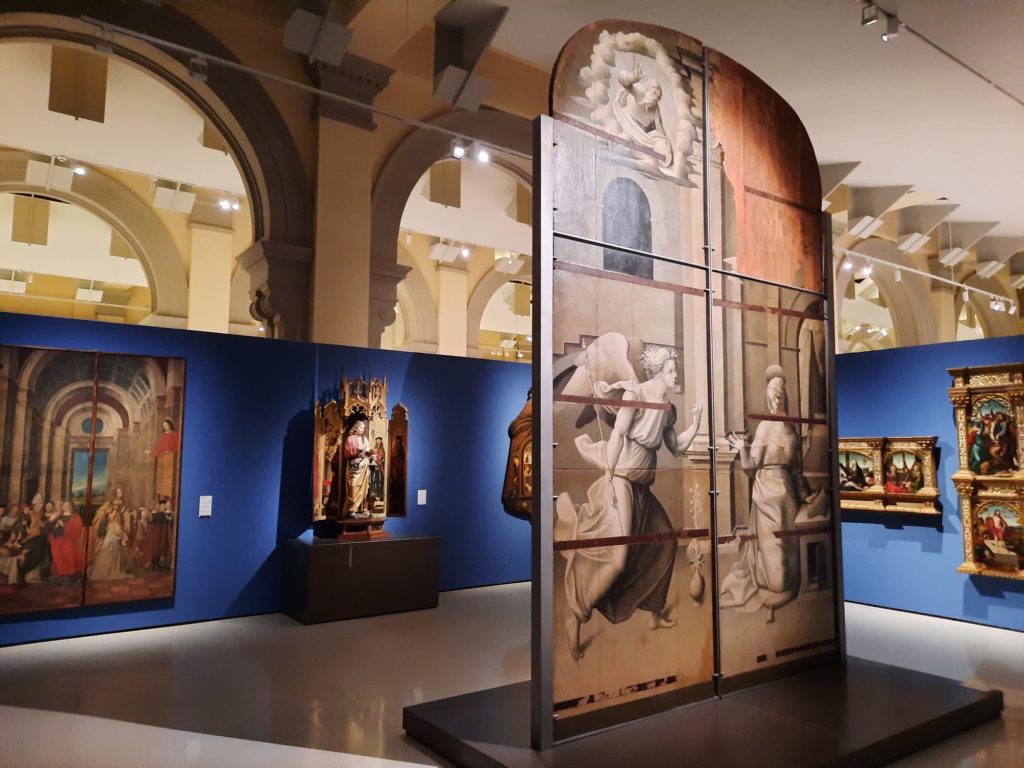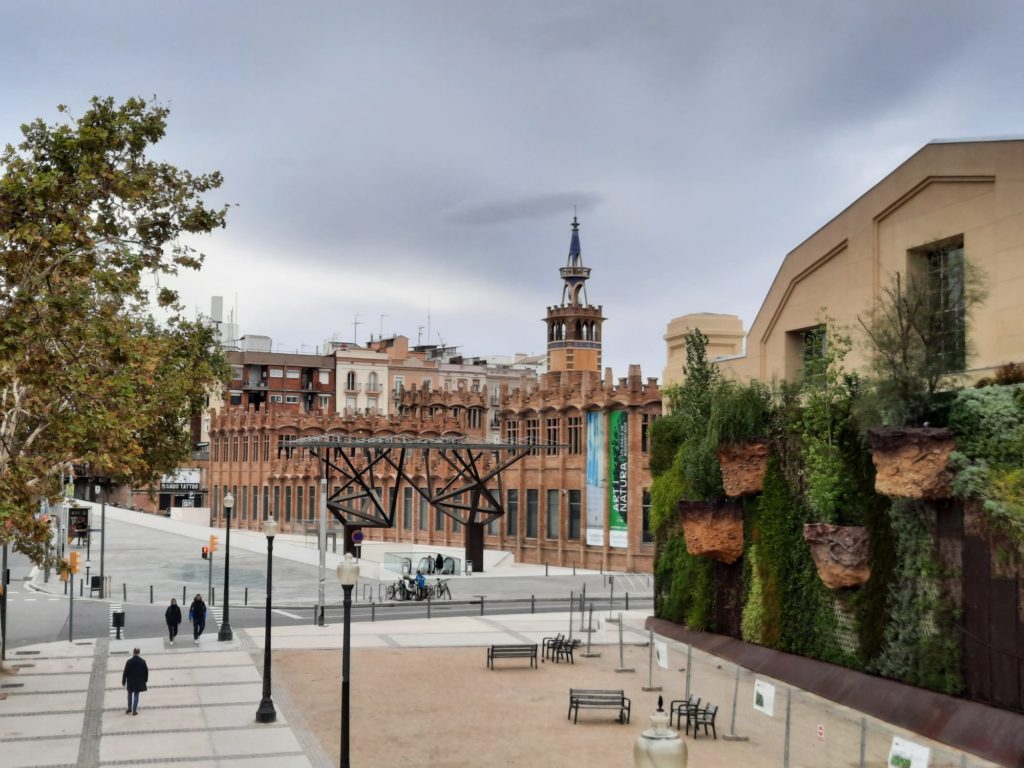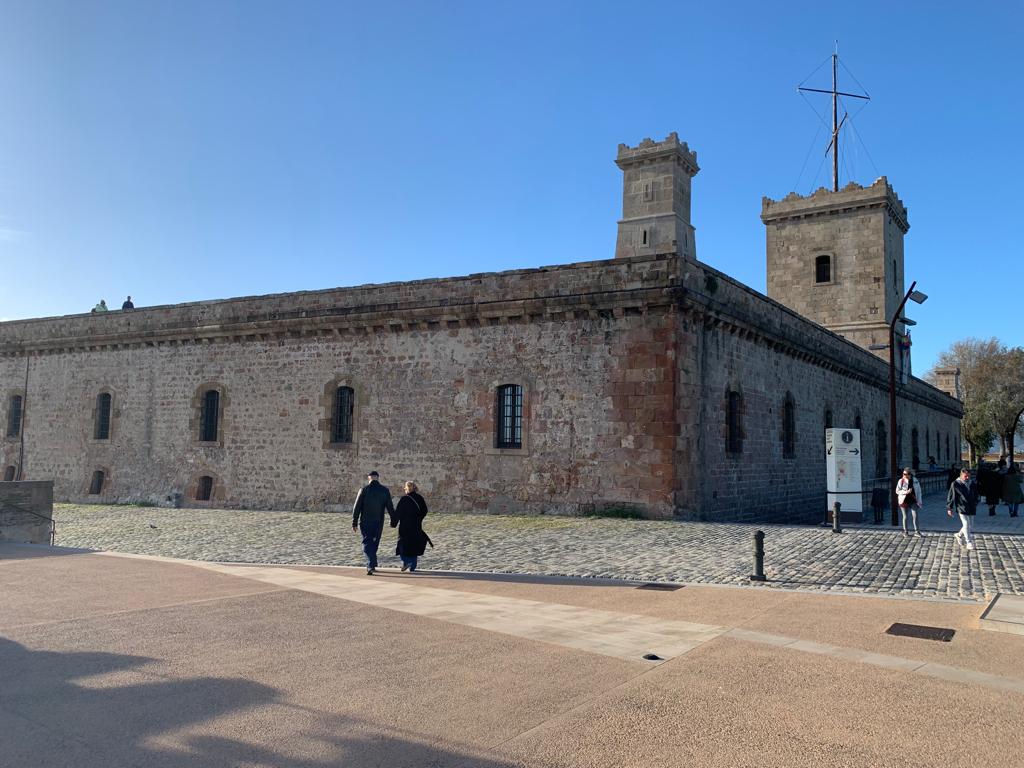A Day In Montjuïc, Barcelona
Montjuïc is a great spot to start exploring Barcelona. A self-contained hill with art, history, and views, set aside a full day to get the most out of a trip here.






An Introduction To Montjuïc
We touched briefly on Montjuïc in my last post, as one of several neighbourhoods visitors to Barcelona may want to explore. This is a historic part of the city: easily defensible and so fortified from an early date. But most of what we see today dates to the 20th Century.
The name Montjuïc translates as “Jewish Mountain” in medieval Latin or Catalan. But there is surprisingly little information out there about where that name comes from. The history of Jewish people in Barcelona echoes the experience in many cities across Europe. In the late 14th Century the Jewish population was around 15% of the city’s total. That came to a violent end in 1391 with pogroms, persecution and forced conversion. There wasn’t a sizeable Jewish population again until the late 19th Century. But from what I can tell, Montjuïc was never home to a Jewish community, it seems to be just a Jewish cemetery which gave the hill its name. That the cemetery is so far from Barcelona’s Gothic Quarter is telling in itself.
So if it wasn’t a Jewish population living here, what was going on on Montjuïc? Well, as I mentioned, it’s been fortified from an early date. Today’s castle dates back to 1640, but stands on the site of several older iterations. It has a bloody history: surveillance and repression, even political imprisonment and executions. Aside from the castle, however, there was very little infrastructure on Montjuïc until the 1929 International Exposition. It was mostly a pastoral refuge from the city: either a place of ill repute or a nice picnic spot depending on who you asked. The fact that large-scale quarantine camps could be erected here at the outbreak of infectious disease in Barcelona tells you how little developed it was at the time.
Let’s take a closer look, then, at how two 20th Century events transformed Montjuïc, before we dive into what there is to see and do today.






The 1929 International Exposition And 1992 Olympic Games
The 1929 International Exposition was a much-delayed event originally meant to take place before WWI. It started out being about electricity and light, before eventually transforming into a more general celebration of technology and progress. Barcelona had form for hosting such events, having greatly modernised the city in preparation for the 1888 Universal Exposition.
Montjuïc was chosen to host the 1929 event for symbolic and practical reasons. Symbolic because it overlooks Barcelona’s harbour and thus maritime history. Practical because it’s next to the port and thus easy to bring in goods and visitors. Hosting the Exposition meant creating a huge amount of infrastructure: roads, plumbing, electricity, transport links, and so on. As always with these big exhibitions, some of the buildings were treated as temporary, while others remained in place. Thus we have big exhibition halls leading up from Plaça d’Espanya (itself built for the Exhibition), the building that is today the Museu Nacional d’Art de Catalunya (MNAC), others used as museums and theatres, an entire town built to show off Spain’s architectural styles, and a stadium at the top of the hill.
Hindsight is 20/20, and the decisions about which buildings to retain were not always the right ones. For instance, Germany’s Pavillion for the Exposition was designed by Mies van der Rohe and Lilly Reich. Strikingly sleek and daring at the time (particularly if you compare it to the remaining original buildings), it has become an icon of Modernism. That did not prevent it from being dismantled at the close of the exhibition, so the version we see today is a faithful 1980s reconstruction.
Nonetheless, the amount of 1929 infrastructure retained on Montjuïc meant that hosting the 1992 Olympic Games here was relatively easy. Or probably not easy, but at least they didn’t have to start from scratch. The Anella Olímpica, or Olympic Ring, sits just behind the MNAC. This cluster of Olympic venues reuses some of what was once built for the Exposition. And the lower half of Montjuïc still retains a strong sense of a place built for moving vast numbers of people in and out. Something about the wide streets, flow to public transport, and today escalators to make the process quicker and easier. These two events have had a significant impact on Montjuïc indeed.






Museu Nacional d’Art de Catalunya (MNAC)
The building which houses the Museu Nacional d’Art de Catalunya (MNAC) was the centrepiece of the 1929 Exposition. At that time it was the Palau Nacional (National Palace), showcasing Spanish art through the centuries. Before becoming the MNAC in 1934, however, it already needed renovation works: quick construction for an Exposition doesn’t translate well into longevity.
Almost a century on, however, the MNAC is thriving. Following more renovations and an extension in the early 2000s, it has now consolidated the entire art collection of around 5,000 works under one roof. The collection falls into a couple of specific focus areas. There are a number of Romanesque church frescoes, removed from churches around the Pyrenees for safeguarding. Then there are what I would broadly term the Old Masters – the types of dramatic religious works and portraits you’re probably imagining. Lastly there is a sizeable modern art collection. Interestingly this is the only section to include a number of decorative objects as well as artworks proper.
My favourite section was the Romanesque art. It is so unlike what I expected it to be. Wooden frames matching the dimensions of the original churches support the salvaged frescoes. A video explains how conservators removed, transported and installed them. It makes for a very unique museum-going experience. Other than this I liked the dramatic chiaroscuros of artists like Francisco de Zurbarán, and enjoyed seeing Catalan artists’ take on modernity.
Aside from the grand approach up the hill, it’s really when you come to the museum’s central space that you can see the building’s origins in the 1929 Universal Exposition. I emerged from the Old Masters into a vast central hall, which dwarfs its resident café, shop and small auditorium. Here and upstairs you find dramatic ceilings: the Palau’s geodesic concrete domes were cutting-edge at the time of their construction.
You could easily spend half a day here, so best to set yourself a time limit or factor that into your planning of your day in Montjuïc.





Other Museums On Montjuïc
Aside from MNAC, there are many other museums you may wish to visit on a day in Montjuïc. I visited one more, as I wanted to have time for some of the other sights as well. You can of course adjust your planning according to your interests! Here are a few suggestions:
- CaixaForum Barcelona: the first museum you will come across on your way up from the Plaça d’Espanya. CaixaForum Barcelona is located in the former Casaramona textile factory, the work of leading Catalan Modernist architect Josep Puig i Cadafalch. It functioned as a factory for less than a decade before shutting down. After that it was a warehouse during the 1929 Exposition, a stables and police parking, before the la Caixa foundation acquired it and turned it into a cultural centre. Today it hosts various contemporary art exhibitions.
- Fundació Joan Miró: as the name suggests, this art museum displays the work of Joan Miró (and more). It was actually Miró’s own project, a space to encourage younger artists to experiment with contemporary art. Miró donated many notable works to the collection, which is on display alongside contemporary exhibitions.
- Museu d’Arqueologia de Catalunya (MAC): one of a few MAC locations across Catalonia. In another 1929 Exposition building, this museum is a fairly standard archaeological survey of the region. There were two things I really liked, however. The first was the use of VR to allow visitors to experience various archaeological sites. The second was that there are Roman mosaics imbedded in the floor that you can walk on. An illicit thrill for the would-be archaeologist.
- Museu Etnològic i de Cultures del Món: a world cultures and ethnography museum, this time in a purpose-built 1970s building. It looks rather nice and I would definitely come here on a return trip.
- Fundació Mies van der Rohe: the reconstructed German national pavilion can be visited today as a museum. It hosts art exhibitions as well as fostering debate on contemporary architecture and urban planning.






Poble Espanyol
I have mixed feelings about this one and don’t wholly recommend it. And that’s not just because I got lost trying to get to it from MNAC (it’s hard to navigate on Google Maps when there are steep hills and closed walkways). The Poble Espanyol (‘Spanish Town’) is another feature of the 1929 International Exposition. The idea is that it is an open-air architectural museum showing off the different architectural styles from around Spain. It has 117 full-sized replica buildings from around the Iberian Peninsula. Our old friend Josep Puig i Cadafalch promoted the idea, but other architects actually executed it.
I really wanted to like the Poble Espanyol, but didn’t entirely for two main reasons. The first is that the timing of my visit to Barcelona meant that the Poble Espanyol was done up for Halloween. It’s a family-friendly sort of place at the best of times, but whatever I had imagined it probably wasn’t ghosts playing the saxophone, giant spiders, and a kiddies’ disco taking over the main square. The second reason is that despite being almost a century old at this point, the Poble Espanyol still has that Disney-esque aura of unreality.
I spent perhaps an hour here wandering around, watching the film on Spanish festivals (“Fiesta: The Soul of Spain”) and having lunch. One benefit of visiting the Poble Espanyol is that you can get products and dishes from the different regions represented in the architecture. I picked up some nougat and had a botifarra washed down with a new season wine.






Castell de Montjuïc and Montjuïc Cable Car
After fortifying myself with a hearty lunch I headed uphill to the cable car station (via the Museu d’Arqueologia de Catalunya). There was a lot more uphill walking to go than I had appreciated. A better idea might be to start your day in Montjuïc here, as you can get a funicular up to the cable car station. Then you can spend the day working your way down. But never mind, I made it, queued for my cable car ticket, and headed up to the Castell de Montjuïc.
I mentioned earlier that the Castle is a 17th Century replacement for older fortifications. And it is very much a hill-top defensive point rather than a residential castle of any kind. There are great views up here of the port on one side and the city on the other, with Tibidabo in the distance. The Castle is fairly bare, but there is an interpretation centre and some wandering to do. On windy days it gets cold and blustery up here so make sure to wrap up warm.
As I had purchased a return cable car ticket, I then headed back down the mountain. The views are spectacular, and the staff adept at ensuring a sensible number of people get in each car to keep the queuing to a minimum. I definitely recommend a return trip. There’s also another cable car which goes to the port, but I didn’t quite figure out where that was.





Olympic Ring
Finally on our day in Montjuïc, let’s take a look at the Anella Olímpica or Olympic Ring. The name had me imagining that the five Olympic Rings would be here, but that is not the case. The Olympic Logo moves with the Games, and this Olympic Ring refers to a ring of Olympic venues overlooking the water.
The Olympic Ring consists of the main venues for the 1992 Barcelona Olympic Games. There is the Olympic Stadium, the Palau Sant Jordi sports hall, the telecommunications tower designed by Santiago Calatrava, the National Physical Education Institute (INEFC) and the Picornell swimming pools. The Joan Antoni Samarach Olympic and Sports Museum is also located in the Olympic Ring.
The Olympic Stadium dates to – you guessed it – the 1929 International Exposition. As part of that event it hosted Spain’s first ever international rugby game against Italy. The next event it should have hosted was a 1936 People’s Olympiad (a protest against the Olympic Games in Berlin). But this plan ended with the outbreak of the Spanish Civil War. So it’s nice that the Stadium was eventually able to host an Olympic Games, albeit with extensive renovations.
What to do with major temporary infrastructure like that for an exhibition or sporting event is often a conundrum. We’ve seen one example in a walk around London’s Olympic Park. But for me Montjuïc is a nice case study: a place transformed by one-off events which has managed to integrate itself into the cultural and sporting life of the city. As I said in an earlier post, it’s well worth a day out of a long weekend in Barcelona.
Trending
If you see this after your page is loaded completely, leafletJS files are missing.

